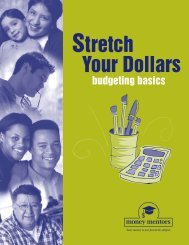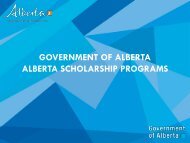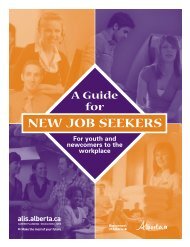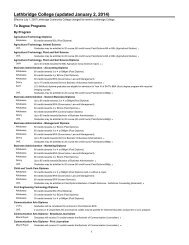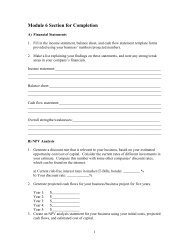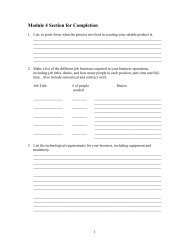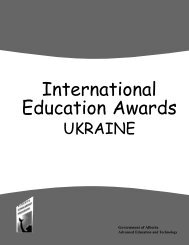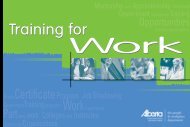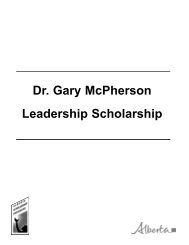Download Publication (PDF) - ALIS - Government of Alberta
Download Publication (PDF) - ALIS - Government of Alberta
Download Publication (PDF) - ALIS - Government of Alberta
- No tags were found...
Create successful ePaper yourself
Turn your PDF publications into a flip-book with our unique Google optimized e-Paper software.
Planning for Post-Secondary is Just a Click AwayPursuing education or training after high school is key to your future. Find out more fromour Learning Clicks Ambassadors! These fun and enthusiastic post-secondary studentswill come to your class and share their first-hand knowledge and experiences about postsecondaryeducation and training.Hear their stories. Ask your questions. Learn how education, training and careers gohand in hand. Get helpWhen is a Learning Clicks Ambassador comingto your classroom? Ask your teacher to requesta presentation at learningclicks.ca/request orcalL 780-415-9277.with planning for postsecondaryeducation andlearn about career options.After the presentation, youwill get a free copy <strong>of</strong> theLearning Clicks USB soyou can explore your futurepossibilities on your own.THIS IS YOURLIFEDO WHAT YOU LOVE,AND DO IT OFTEN.IF YOU DON’T LIKE SOMETHING, CHANGE IT.IF YOU DON’T LIKE YOUR JOB, TRY SOMETHING NEW.IF YOU DON’T HAVE ENOUGH TIME, STOP WATCHING TV.IF YOU ARE LOOKING FOR THE LOVE OF YOUR LIFE, STOP;THEY WILL BE WAITI NG FOR YOU WHEN YOUSTART DOING THINGS YOU LOVESTOP OVER ANALYZING, LIFE IS SIMPLE.ALL EMOTIONS ARE BEAUTIFUL.WHEN YOU EAT, APPRECIATE EVERY LAST BITE.OPEN YOUR MIND, ARMS, AND HEART TO NEW THINGSAND PEOPLE, WE ARE UNITED IN OUR DIFFERENCES.ASK THE NEXT PERSON YOU SEE WHAT THEIR PASSION IS,AND SHARE YOUR INSPIRING DREAM WITH THEM.TRAVEL OFTEN;GETTING LOST WILLHELP YOU FIND YOURSELF.SOME OPPORTUNITIES ONLY COME ONCE, SEIZE THEM.LIFE IS ABOUT THE PEOPLE YOU MEET, ANDTHE THINGS YOU CREATE WITH THEMSO GO OUT AND START CREATING.LIFE ISSHORTLIVE YOUR DREAM,AND WEARYOUR PASSION“The Holstee Manifesto” ©2009www.holstee.com/manifesto
How It Works“People say that you’regoing the wrong way whenit’s simply a way <strong>of</strong> your own.”angelina jolieCareer and Education PlanningWhat most people think a career path should look like:What most career paths look like in reality:IT'S A WAY OFLOOKING AT LIFE 1• be flexible - make plans butstay open to unexpected eventsand opportunities• today's job market is constantlychanging - be ready to changeand adapt with it• stay curious - embrace lifelonglearning and look for ways tocontinually develop and grow• build skills and experience inareas that interest you - it mightopen doors to things you didn'teven know existed!Career planning isn’t a one-time decision - it's an ongoing cycleyou will repeat many times throughout your life. In a world wherethings are constantly changing, your career path will change too.Start by knowing yourself - find something you’re good at andenjoy – and go from there. Your path will follow. Where you g<strong>of</strong>rom here is up to you.Doodle your thoughtsTHE 4 STEPS <strong>of</strong> career and education planningknowyourselfchoose adirectionexploreoptionsmake ithappenalis.alberta.ca/high-school Introduction 3
DID YOU KNOW?Career planning. It sounds so <strong>of</strong>ficial, and probably more than a little overwhelming. But, if you've ever• met someone and thought "their job sounds cool - I could do that"• started a conversation with your parents or friends about what you might do after high school• taken a course that gives you post-secondary level credits (RAP, CTS pathways, etc.)• had a hobby, sport, or activity you really enjoyed and wondered if you could make money doing itYOU'VE ALREADY STARTED!"Don’t ask yourself whatthe world needs;ask yourself whatmakes you come alive.And then go and do that."harold whitmanPeople with AnswersSo, how do you go from having an idea about what you might like todo after high school to making some plans? Start by talking to peopleyou know - their advice and experience is invaluable.Fill in the web below with people from your family, friends, school,work - anyone that can help you on your journey!SchoolJoe from workFriendsSam from hockey4 <strong>Alberta</strong> Enterprise and Advanced Education A Career and Education Planning Guide
NOTE!You'll be visiting<strong>ALIS</strong> (alis.alberta.ca)<strong>of</strong>ten - bookmark it now!<strong>ALIS</strong><strong>Alberta</strong> Learning Information ServiceThe <strong>ALIS</strong> website (pronounced Alice) has information, tools andresources to help you with every step in the career planningprocess including• career planning• exploring occupations• education after high school (post-secondary)• paying for post-secondary education• employment options and work search<strong>ALIS</strong>What You'll Find HereExplore the High SchoolStudents tab• choose a topic in the leftnavigation menu• click on a checklist• view the next stepsContact the Career InformationHotline• find contact informationfor Career Advisors who willprovide answers to your career,learning and employmentrelatedquestions6 A Career and Education Planning Guide<strong>Alberta</strong> Enterprise and Advanced Education
Getting StartedEducation in <strong>Alberta</strong>“Doing your best at this momentputs you in the best placefor the next moment.”oprah winfreyCampus <strong>Alberta</strong>You may have heard the term Campus <strong>Alberta</strong>. It refers to <strong>Alberta</strong>’s postsecondarysystem and schools working together to provide the best possibleopportunities for you, the student. This means that your education pathwaycan be as unique as you are.The way to succeed in higher educationis to find your “best fit” program or uniquepathway. This means the right program,at the right institution, at the right time.Use this resource to learn about planningyour career and education, and to geta feel for what options are available.Then, go out and explore how theseopportunities can lead you to your goals.95%employment rate <strong>of</strong><strong>Alberta</strong>ns25-35 with apost-secondarycertificate,diploma or degree17$31/hr 3/4average hourlyearnings for aperson with auniversity degreethe averagenumber <strong>of</strong> worktransitions youwill likelyexperience in yourcareeron average, theportion <strong>of</strong> students'educational costscovered by theprovincialgovernment$1 million Earn over more* during your career*post-secondary graduates compared to those with a high school degree 2DO SOMETHING!You don't need to have all the answers or get everything figured out right now. What'simportant is to always be doing something that helps move you forward toward your goals.• volunteer - get involved while gaining experience• try new things - figure out what you like (and what you don't like)• meet new people - expand your network• ask questions - go online, visit schools, talk to students• get extracurricular - join a team• look around - who do you know that seems happy? who is living a life that you admire?alis.alberta.ca/high-school Introduction 7
Step OneKnow Yourself"I don’t want to be the next Michael Jordan.I only want to be Kobe Bryant." kobe bryantIn this section you will do some quizzes and exercises that will give you a better idea<strong>of</strong> who you are and what you want, and equally important, what you don’t want.When you know yourself, you can create a careerplan based on what's important to you. Knowingyourself involves answering questions like• What’s important to me?• What inspires me?• What am I good at?How to do this!My Personality CodeStep 1: How I Like to Get Energizedm I like being with peoplem I prefer talking to people in person ratherthan emailing or textingm I have a high energy levelm I get lonely when it is too quiet around mem I get to know people quite quicklyTOTAL = EStep 2: How I Like to Get INFORMEDThere are five sets <strong>of</strong> statements in each section.From each set, select the statement in eitherthe left or right column that best describes whoyou are most <strong>of</strong> the time. Choose what feels mostnatural for you, not what your family, friends orteachers expect from you.m I like spending time on my ownm I like communicating more through emailor textingm I have a quieter energy levelm I like it when it is quiet around mem I like to take my time in getting to knowpeopleTOTAL = Irelates to yourcomfort level withina group situationm I like clear instructions to do thingsm I would rather do something than sitaround and think about itm I like things done in the proper orderm I like it when things are predictablem I seek accuracy in my workTOTAL = Sm I like challenging the way things are donem I like figuring out how things workm I can get things done in random orderm I find change/improvements excitingm I seek creativity in my workTOTAL = Nrelates to how we takein information from theworld around us8 <strong>Alberta</strong> Enterprise and Advanced Education A Career and Education Planning Guide
elates to how weprefer to makedecisionsrelates to how weinteract with theworld and how we liketo live lifeStep 3: How I Like to MAKE DECISIONSm I take a reasonable and logicalapproach to difficult situationsm I can remain calm in emergenciesm I generally like math and sciencem I am okay with conflictm I prefer to work independentlyTOTAL = TStep 4: How I Like to LIVE LIFEm I bring harmony and “win-win” solutionsto difficult situationsm I get more emotional in emergenciesm I generally like subjects that focus onpeople and creativitym I am uncomfortable with conflictm I prefer to interact with peopleTOTAL = Fm I am the kind <strong>of</strong> person who follows therulesm I like following a plan or schedulem I am on time or early for thingsm I am well prepared and tend to dothings ahead <strong>of</strong> schedulem I tend to take life seriouslyTOTAL = Jm I am the kind <strong>of</strong> person who will followthe rules until they get in my waym I like to leave things open or unstructuredm I am <strong>of</strong>ten late or just in time for thingsm I tend to be “pressure prompted” and domy best work at the last hourm I tend to have a lot <strong>of</strong> fun in my lifeTOTAL = PFigure out the totals for each section. Write theletter with the highest number <strong>of</strong> responses ineach step in the My Personality Code box.My PersonalityCodeGo online and search for your personalitycode + careers (ie. IFTP + careers). Check outa few websites to find personality pr<strong>of</strong>iles andoccupations that match who you are. Record afew <strong>of</strong> the occupations you find interesting below.GOOGLE IT!occupations:alis.alberta.ca/high-school Step One: Know Yourself 9
"Why fit in when you wereborn to stand out?" Dr. SeussMy Personality CodeESTJ: here to take care<strong>of</strong> businessESTP: here to take actionESFJ: here to supportESFP: here to bring energy“I like being responsible andworking hard to make suregoals are met.”“I like investigating why thingshappen and thinking on myfeet to solve problems.”"I like being responsible andgiving advice to help peoplelead better lives.""I like using my kindness andenthusiasm to help people increative ways."ENTJ: here to take charge"I like solving complexproblems, improving theworld around me and leadingpeople in new directions."ENTP: here to create“I like challenge, technologyand inspiring the world aroundme using my big picturethinking!”ENFJ: here to promote"I like helping peopleand building cooperativerelationships by leading andcoaching."ENFP: here to help"I like people, variety andimproving the world aroundme with my creativity and bigpicture thinking!"ISTJ: here to do it right"I like being responsible andmaking things more efficient,especially in the technicalworld."ISTP: here to troubleshoot"I like solving problems andhandling emergencies onthe fly."ISFJ: here to do my duty"I like being responsible andworking hard to help people."ISFP: here to help,hands-on"I like working one-on-onewith people to help makethings better for them."INTJ: here to bringperfection"I like thinking outside the boxto bring the world new andexciting visions."INTP: here to bringamazing solutions"I like thinking about complexproblems and using creativethinking skills to solve them."INFJ: here to bringpositive change"I like making a differencein people’s lives by doingsomething worthwhile."INFP: here to bring peace"I like helping peoplein a way that is creativeand meaningful."My Top Five Needs and WantsThese play a huge role in the choices you make.Which five factors below are the most important to you in a career?NOTE!If you are finding this activitydifficult, come back aftercompleting the next sectionon self-assessment.m working in a field that interests mem work/life balancem job security and benefitsm accommodates my culture or religionm making a lot <strong>of</strong> moneym opportunities for personal growth/chance todevelop my skillsm number <strong>of</strong> years <strong>of</strong> schooling required/costto take the needed post-secondary programm <strong>of</strong>fers opportunities to advancem flexibility to adapt work to changing lifecircumstance (family, return to school, etc.)m knowing the work I do makes a difference/haspurposem aligns with what my family wants or expectsm doing something I like/something I'm good atm other:10 <strong>Alberta</strong> Enterprise and Advanced Education A Career and Education Planning Guide
1 - go here Click the link and create a pr<strong>of</strong>ileCAREERinsite<strong>ALIS</strong> has a great career planning site (alis.alberta.ca/careerinsite) where you can doquizzes and exercises that will give you a better idea <strong>of</strong> who you are and what you want.CAREERinsite will provide occupation suggestions and provide results from multiplequizzes to give you the best personalized recommendations possible!WHAT RESULTSARE YOU GETTING?Don't worry if you're not interestedin the occupations that come up.Instead, focus on the patterns:• suggestions that are repeated• occupations in the same field(health care, education, etc.)• jobs that use similar skills andabilities (organizing, problem solving,writing, etc.).Look for things that align with yourstrengths, interests and goals.2- sign upto save your quiz results.Self-assessment quizzes and exercises3- do theseDo the quizzes and exercises in theKnow Yourself section. You can returnto change your answers at any time."I like the fact that some <strong>of</strong> thequizzes led to possible occupations.It may lead students down anon-traditional path which is quiteexciting."marc, learning clicks ambassadorlearningclicks.caalis.alberta.ca/high-school Step One: Know Yourself 11
My Self-Assessment ResultsMy Top Five Needs and Wants:12345My Personality Code:(page 9)(page 10)Show your results toyour network andget their thoughts.Then do what's rightfor you!Occupations:1234578910(page 9 & My Career Plan - CAREERinsite)Staple yourCareer Plan <strong>PDF</strong>to this sheet!alis.alberta.ca/high-school Step One: Know Yourself 13
Where am I Right Now?Before you make plans to move forward, it's helpful to have a clearpicture <strong>of</strong> where you're starting. Take a few minutes to answer thesequestions. 3Talk to your studentadvisor, guidancecounsellor or careerpractitioner for help withthis activity.Do I have an occupation inmind? A post-secondaryprogram?Who can helpme answer thesequestions?• things I do well• what I enjoy doingWhat do I need to knowright now to movetoward my ideal future?Am I taking the rightcourses?Do I have a plan for how topay for education or trainingI take after high school?14 <strong>Alberta</strong> Enterprise and Advanced Education A Career and Education Planning Guide
RichardEven though I always wanted to be an X-ray Technician,I ended up taking Commerce in University because myparents thought business was a better choice.It didn't take long after graduating and starting an <strong>of</strong>ficejob to realize I'd been right all along - I wasn't happyworking in the business world. I wanted to be workingon the front line interacting with people, not sitting at adesk writing reports.I started thinking about how I'd always been interestedin the health care field so I decided to check out someprograms and job postings.NOTE!Nothing except your ownjudgment can fully capture theunique complex person you are.Check what you have learnedagainst your own gut feelings orintuition. Interpret your resultsusing your own common senseand self-knowledge.Last year I started an MRI technicianprogram. I'm so much happiernow that I'm doing something Ienjoy that fits with who I am.Real-lifeStoriesAngelaWhen I graduated from high school, I had no idea whatI wanted to do. All I knew was I wanted to be involved insome kind <strong>of</strong> post-secondary program.I graduated with a business degree seven years after Istarted, but I took my schooling in a way that allowedme to explore my interests and balance my life.JulieI've always loved to travel. After high school I wasn'tsure what I wanted to do so I moved to Australia for ayear to work and explore. When I came back to <strong>Alberta</strong> Istarted a general degree program. Even then I used anyfree time I had to travel.One day I realized that my education andmy hobbies didn't have to be separatethings, so I enrolled in a Global andDevelopment Studies program, and Ihaven't looked back.Since then I've participated in a work/study exchange in rural Mexico andcompleted a year-long internship withthe Canadian International DevelopmentAgency (CIDA) in South Africa. My goal isto one day work for a Canadian embassyabroad.During those seven years, I studied in three differentprograms, took courses at four different post-secondaryschools, took time <strong>of</strong>f at various points to work andtravel, participated in distance and e-learning, wasfrequently a part-time student and using the transfersystem, graduated with the degree I wanted.Some people might find it unconventional, but I lovedbeing able to customize my education in a way thatworked best for me.alis.alberta.ca/high-school Step One: Know Yourself 15
Step TwoExplore Possibilities"I’m doing it because I choose it.And if it’s not working,I can make a change." alanis morissetteIn this step you're looking at options. You'll learn how to research your choices and discover whatresources are out there to help you keep exploring possibilities. You’ll explore three <strong>of</strong> yourpotential occupations in depth.The occupations you chose to explore today are not necessarily the ones you will choose topursue after high school. Your skills, interests and personality will continue to change and develop.So, keep repeating the career and education planning steps as you and your plans change.OCCinfo—Occupation InformationOCCinfo has more than 500 pr<strong>of</strong>iles on various occupations in <strong>Alberta</strong> - visitalis.alberta.ca/ocinfo. Each pr<strong>of</strong>ile has detailed information about:Doodle your thoughts!DutiesWhat work might Iactually be doing ina particularoccupationWorkingConditionsWould I be workinginside or outside; at adesk or on my feet?Are there long workdays or shift work?EducationalRequirementsWhat type <strong>of</strong>education ortraining do I need?How long will it taketo complete?PersonalCharacteristicsWhat type <strong>of</strong>people enjoy thiswork?Employment &SalaryWhere could Iwork? How muchmoney would Imake?RelatedOccupationsWhat else could Ido that's similar?16 <strong>Alberta</strong> Enterprise and Advanced Education A Career and Education Planning Guide
OCCinfo Word ScrambleUnscramble the words below to discover the different search optionsyou can use to find occupations on OCCinfo. SEARCH BY:1 - go here 2 - playtltiealis.alberta.ca/occinfoitenesrtbsutecjtnudrsyiTry out the differentsearch options and seewhat you come up with.conocdeemrgineg3- save itIf something interests you,save it to your Personal List.Before you leave, printyour list or write some<strong>of</strong> your possibleoccupations below.NOTE!If an occupation looks interestingbut is not quite right for you,check out Related Occupationsin the pr<strong>of</strong>ile.Chances are you’ll choosea career for reasons asunique as you are.• turn your interest in musicinto a career in the recordingindustry• let the people who caredfor you in the hospital inspireyou to go into health care• use your love <strong>of</strong> travel toget involved in recreationand tourismAnswerstitle, interest, subject, industry, noc code, emergingalis.alberta.ca/high-school Step Two: Explore Possibilities 17
Choose Your Top ThreeOut <strong>of</strong> all the potential occupations you came up with in Steps 1 and 2,choose your top three.NOTE!Think about the web youcreated in Step 1 - how dothese align with the futureyou want?Occupational Pr<strong>of</strong>ilesNow that you've narrowed down your choices to yourtop three, learn more about them!1 - go here3 - fill it inalis.alberta.ca/occinfoUse Search by Titleto find pr<strong>of</strong>iles for each<strong>of</strong> your three occupations.Use the information in thepr<strong>of</strong>iles to fill out theMy Top 3 on the next page.Can't find iton OCCinfo?If you can't find one <strong>of</strong> yourchosen occupations, trylooking for a simpler title.2 - searchWatch the VideosThere are more than 200 five-to-six minute videos withreal people giving an inside view <strong>of</strong> their occupation on the<strong>ALIS</strong> website (alis.alberta.ca/videos).For example, if you're looking forfine arts teacher, look up teacherand then the form <strong>of</strong> fine arts youare interested in (i.e. dance).When completing the chart,combine information from bothpr<strong>of</strong>iles.Still can't find whatyou're looking for?GOOGLE IT!Add any new or interestinginformation you learnto your chart!18 <strong>Alberta</strong> Enterprise and Advanced Education A Career and Education Planning Guide
MY TOPTHREEStay open to possibilities.70% <strong>of</strong> high school and universitystudents report that at least onechance event influenced theireducational and career choices. 4DutiesWorkingConditionsPersonalCharacteristicsEducationalRequirementsOtherRequirementsEmployment &AdvancementSalary/WageRelatedOccupationsalis.alberta.ca/high-school Step Two: Explore Possibilities 19
Try It In High School!"You miss 100 per cent <strong>of</strong>the shots you never take."wayne gretzkyHigh school <strong>of</strong>fers tons <strong>of</strong> opportunities to try out different things that interest you. The crossword puzzlebelow uses examples <strong>of</strong> different programs and courses you can take to gain hands-on experience.Use the information on the next page to answer the questions!12345678represents spaces between words910ACROSS2 provide first-hand experiences and exposureto different career possibilities5 similar to CTS courses, these <strong>of</strong>fer hands-onexperience in a variety <strong>of</strong> fields7 taking these courses can open doors <strong>of</strong>opportunity around the world8 work experience course that prepares you forentry into trade, technology and service careers9 develop leadership skills, give back to yourcommunity, gain experience and earn credits10 earn while you learn, and get a head start inyour tradeDOWN1 earn credits working in your community whilediscovering your interests and skills3 spend time with someone on the job and learnfirst hand what they do4 an agricultural training program with anapprenticeship style <strong>of</strong> delivery6 explore how Aboriginal people are working tomaintain and promote their cultural valuesAnswers can be found on page 4320 <strong>Alberta</strong> Enterprise and Advanced Education A Career and Education Planning Guide
Discover What You Love To DoIf any <strong>of</strong> these options sound interesting to you, try them! You won'tknow if something is really for you until you experience it for yourself.Try as many as possible!Career and Technology (CTS) CoursesProvide first-hand experience and exposure todifferent career possibilities. Learn more aboutthe CTS options available to you on page 22.Knowledge andEmployability Courses, FineArts, Social SciencesSimilar to CTS courses, these<strong>of</strong>fer hands-on experience in avariety <strong>of</strong> fields.Work Experience 15-25-35Discover your skills andinterests while earning creditsworking in your community.Language ProgramsGreen Certificate ProgramAn agricultural training program with anapprenticeship style <strong>of</strong> delivery. Learn byactively performing the skills required.MentoringDevelop leadership skills and gain realworldexperience working with youthwhile giving back to your communityEarn credits in any <strong>of</strong> the five availablementoring courses.Career internship 10Prepares you for entry into trade, technology andservice careers by placing you with local business,government or volunteer organizations to gain workexperience in that field.Recommended as a prerequisite to RAP and othertechnology or service career-related programs.Knowing another language can opendoors <strong>of</strong> opportunity around the world.Job ShadowAboriginal StudiesExamine how Aboriginal peoplesare working toward maintaining andpromoting their cultures and values.Registered ApprenticeshipProgram (RAP)Find someone who works in anoccupation you’re interested in.Spend time learning about thework they do and see if you couldspend a day on the job with themlearning first hand what they do.Earn while you learn and get a headstart in your career! See page 29 formore information.alis.alberta.ca/high-school Step Two: Explore Possibilities 21
Career & Technology Studies (CTS)- Explore Your Interests2 TYPESSpecialized Skill Pathways...are a group <strong>of</strong> courses based on your individualinterests in a field <strong>of</strong> study.e.g. Event Planner, Outdoor Guide, Court ClerkCreate and SelectPersonalized Pathways• a group <strong>of</strong> courses* that allow youto explore and develop the attitudes, skillsand knowledge for a career relevant toyour interests• support goals that may include university,college, apprentice training or movingdirectly into the workforce*5 groups <strong>of</strong> courses relatedto specific areas <strong>of</strong> work• Business, Administration, Finance& Information Technology (BIT)• Health, Recreation & Human Services (HRH)• Media, Design & Communication Arts (MDC)• Natural Resources (NAT)• Trades, Manufacturing & Transportation (TMT)Credentialed Pathways...are a series <strong>of</strong> specific courses leading to a credentialor credit awarded by a recognized industry or communityorganization or post-secondary institution.e.g. Welder, A+ Certification, Computer Repair TechnicianIs being self-employed right for you?Do you have a flair for creativity, love challenges and enjoy taking on a leadership role?These characteristics, together with a good business idea and business training couldbe the right ingredients to start your own company.Learn more about entrepreneurship at alis.alberta.ca/self-employment andalis.alberta.ca/rocketfuel.22 <strong>Alberta</strong> Enterprise and Advanced Education A Career and Education Planning Guide
Connecting Learning to LifeSome <strong>of</strong> the courses you're taking might feel irrelevant right now because youcan't see how they mean anything to "real life." Try this activity to see howtaking core and options courses in school relates to the possibilities for yourfuture.Check out the Search by Subjectfeature on OCCinfo - choose yourfavourite core course and a favouriteoptions course to discoveroccupations that use both!Options coursesgive you the opportunity toexperience hands on whatit's like to work in a specificoccupation or job.Core coursesgive you a foundation <strong>of</strong>knowledge to build onand help you discover yourstrengths and interests.In Your WordsWe asked <strong>Alberta</strong> high school students how they'redeciding on potential occupations. Here's what they told us:Math + Music= Sound EngineerBiology + Comm Tech= Forensic Lab AnalystSocial + Fashion= Theatre Productionm personal experience – "hobbies, volunteer work, thingswe like to do, subjects we like"m "career quizzes that we take at school or find online"m "hearing about what our parents, family, role modelsand people in the community do"m based on "the kind <strong>of</strong> lifestyle we want" (opportunitiesto travel, ability to balance home and work life, chanceto earn a good income)m "stuff we've done at school like the RAP program andCTS courses"m "thinking about things we already do well and finding outif we can make money doing them" (working on cars,doing hair and makeup with friends, playing sports)m when people tell us “you’d be really good at…”Volunteer and discover your strengthsMost non-pr<strong>of</strong>it and service organizations are looking for volunteers. Ask if they need help!This is a great way to learn about occupations, discover which work environments you find interesting andenjoyable and get some experience at the same time.Check out alis.alberta.ca/youthreflections to see videos <strong>of</strong> real students gaining experience by volunteering.Find the tip sheets Volunteer, Putting Your Volunteer Experience to Work for You and Volunteer, Build YourCareer While Helping Others at alis.alberta.ca/tips.alis.alberta.ca/high-school Step Two: Explore Possibilities 23
Step ThreeChoose a DirectionIt adds up:Secondary+ Post-SecondaryPossibilities!(high school)(College, university,apprenticeship training, etc.)You’ve got your top three potential occupations. Thisstep will teach you how to figure out what you wouldneed to do if you chose to pursue one <strong>of</strong> these. Formost occupations, you would head towards a postsecondaryeducation.What is Post-SecondaryEducation?• the learning and training that comes after a highschool education• it’s much more than just university and collegeNOTE!You may or may not end upin one <strong>of</strong> the post-secondaryprograms you explore in thisstep. You might change yourmind and your direction severaltimes before you finish highschool.Step 3 will show you how to findinformation that will help youchoose a direction when you'reready.DID YOU KNOW?The approximate average full-time yearlysalary in <strong>Alberta</strong> with 6• less than high school is $35,442• a high school education is $39,196• potential with a post-secondaryeducation is $73,607Not getting a post-secondary educationwill cost you more than getting one,even taking into account the cost <strong>of</strong> theeducation and the income you don’t earnwhile in school. 7In Your Wordsin recent high school student survey's, 5 students statedm 95% or more are planning to take some type <strong>of</strong> postsecondaryeducationmmroughly 50% <strong>of</strong> those have some idea <strong>of</strong> the program orschool they want to enroll inthe number one source students use for information isGOOGLE, followed by parents and older siblings,teachers, people in their networks and communitiesand school websites24 <strong>Alberta</strong> Enterprise and Advanced Education A Career and Education Planning Guide
"With the changing economy,no one has lifetime employment.But [post-secondaryeducation] provides lifetimeemployability."U.S. president barack obamaWhy Get a Post-SecondaryEducation?Brainstorm some reasons why it's a good idea to get a post-secondaryeducation and fill in the Advantages <strong>of</strong> a Post-Secondary Educationweb below.More choices<strong>of</strong> jobsPersonalgrowthAdvantages <strong>of</strong> aPost-secondaryEducationMore globalopportunitiesMore interestingcareer opportunitiesDID YOU KNOW?The longer you stay in school, the more OPTIONS you will have in life.EVERYONE can go to post-secondary, and there are many ways to helppay for it.There are many people and resources to help YOU go to post-secondary.Ask your network for help.alis.alberta.ca/high-school Step Three: Choose a Direction 25
How Well Do You Know YourPost-Secondary Options?Match the type <strong>of</strong> school to the programs and options they <strong>of</strong>fer.A couple have been done for you. Check out pages 27 and 28 formore information on types <strong>of</strong> post-secondary schools and programs."Education is not the answerto the question.Education is the means to theanswer to all questions."william allinlocated in corecity locationsmay <strong>of</strong>fer universitytransfer and applieddegree programs<strong>of</strong>fer culturallyrelevantprogrammingsome are known for beingresearch intensivethere are 3 types <strong>of</strong> thiskind <strong>of</strong> post-secondaryinstitution<strong>of</strong>fer apprenticeship,certificate, diploma andsense <strong>of</strong> community,support and belongingopportunities togain practicalskillsdegree programs only type <strong>of</strong> institution to<strong>of</strong>fer religious traininglocated in bothurban and ruralsettingsTechnical InstitutesUniversityPublic CollegesPrivate CollegesAboriginal Colleges<strong>of</strong>fer broad range<strong>of</strong> programmingpromote Aboriginalculture, history andknowledgeEducationVideosprimarily focused towardtechnical careerssome <strong>of</strong> these <strong>of</strong>ferlicensed vocationaltrainingonly type <strong>of</strong> institutionto <strong>of</strong>fer graduate levelstudy opportunitiesWatch videos <strong>of</strong> realstudents attending eachtype <strong>of</strong> institution atalis.alberta.ca/educationvideos.26 <strong>Alberta</strong> Enterprise and Advanced Education A Career and Education Planning Guide
What Types <strong>of</strong> Post-SecondarySchools are out There?DID YOU KNOW?Offer apprenticeship, certificateand diploma and degree programsfocused primarily towards technicalcareers.Why Choose?• provide opportunities to gainpractical skills that are marketfocused and currently in demandby employers• provide a quality educationoriented to career and technicalprogrammingTechnical InstitutesOffer a wide range <strong>of</strong> academicand pr<strong>of</strong>essional programs. Someuniversities are research intensive and<strong>of</strong>fer graduate studies.Why Choose?• located in core city locations across<strong>Alberta</strong> (e.g. Edmonton and Calgary),allowing students to live at home ormove out on their own to attend• <strong>of</strong>fer on-campus and/or onlinedelivery <strong>of</strong> courses• there are a wide variety <strong>of</strong> institutionsand programming available...DO YOUR RESEARCH!With more than 200 post-secondaryschool locations and more than2,700 post-secondary programs<strong>of</strong>fered in <strong>Alberta</strong>, everyone canfind something that matches theirneeds, wants and interests!alis.alberta.ca/EDinfoOffer a broad range <strong>of</strong> programmingincluding apprenticeship, certificate,diploma, foundational learning andacademic upgrading. These institutionsmay also provide university transfer andapplied degree programs. One collegespecializes in Fine Arts programs and only<strong>of</strong>fers Bachelor <strong>of</strong> Fine Arts (BFA) andBachelor <strong>of</strong> Design (BDES) degrees.3 TYPES1) Degreeprimarily <strong>of</strong>fer liberal arts, science,business and education degrees ina smaller, more personalizedclassroom setting.2) Licensed Vocational Training<strong>of</strong>fers short-term programs thatlead to specific jobs.3) Religious Trainingprovies training in the theologyand scriptures <strong>of</strong> a recognizedfaith group.Private CollegesUniversitiesOffer a variety <strong>of</strong> programs that meetthe needs <strong>of</strong> Aboriginal students andcommunities and help to promoteAboriginal culture, history and knowledge.Why Choose?• education and training in anenvironment that includes culturallyrelevant programming, counsellingservices and access to elders• encourage a sense <strong>of</strong> community,support and identity/belongingAboriginal CollegesWhy Choose?• provide adult learning opportunitiesthroughout <strong>Alberta</strong>• located in both rural and urban centersacross <strong>Alberta</strong>, so students may nothave to move away from homePublic CollegesNOTE!Many <strong>of</strong> <strong>Alberta</strong>'s postsecondaryschools <strong>of</strong>feronline coursesand programs.Visit page 34 to learnmore about distance/online learning.alis.alberta.ca/high-school Step Three: Choose a Direction 27
What Types <strong>of</strong> Programscan I Take?There are many types <strong>of</strong> programs <strong>of</strong>fered at post-secondaryinstitutions in <strong>Alberta</strong>. These programs vary in length, result in earningdifferent credentials and ultimately lead to different types <strong>of</strong> work."I haven't chosen a programyet but it’s not a question <strong>of</strong>IF I'm going, it’s WHAT I'llbe taking so that's what I'mtrying to figure out now."<strong>Alberta</strong> high school studentCERTIFICATE PROGRAMS• short-term programs that provide entry into a specific occupation• generally one year or less <strong>of</strong> full-time studyDIPLOMA PROGRAMS• prepare students for employment in a particular field or group <strong>of</strong> occupations• generally two years <strong>of</strong> full-time applied studyNOTE!For more information, go toalis.alberta.ca/programdifferencesfor the tip sheet,Certificate, Diploma, AppliedDegree, Degree . . . What’s theDifference?APPLIED DEGREE PROGRAMS• enhanced career preparation that combines theoretical learning (classroom)with practical application (hands-on experience)• can lead to opportunities beyond entry level• four-year programs (about three years <strong>of</strong> academic study and one year <strong>of</strong>related work experience)BACHELOR DEGREE PROGRAMS• theoretical or academic learning with direct access to graduate studies• three or four years <strong>of</strong> full-time studyAPPRENTICESHIP PROGRAMS• combine on-the-job training with technical training delivered in a classroom• one to four years <strong>of</strong> combined work and studyTIME TO CHOOSEThis publication gives you• details on the types <strong>of</strong>post-secondary schools andprograms available in <strong>Alberta</strong>• a chart showing programsand where they are <strong>of</strong>fered• features chart listing eachschool's services<strong>Download</strong> this resource atalis.alberta.ca/publications(key phrase: Time to Choose)28 <strong>Alberta</strong> Enterprise and Advanced Education A Career and Education Planning Guide
The Trades:Careers with a Bright FutureTradesecretsFor more information onapprenticeship, visit theTradesecrets website attradesecrets.alberta.ca.Apprenticeship is a great post-secondary choice. Learn moreabout careers in the trades at alis.alberta.ca/apprenticeship.What is Apprenticeship?• post-secondary education leading to certified journeypersonstatus• a combination <strong>of</strong> on-the-job learning (80%) and classroomtechnical training (20%)• a program that takes between one and four years to complete,depending on the tradeNOTE!The Registered ApprenticeshipProgram (RAP) is for high schoolstudents who want to learn theskills <strong>of</strong> a trade while earning highschool credit.• earn credit toward anapprenticeship program• earn credit toward your<strong>Alberta</strong> high school diploma• earn a wage for your time onthe jobFor more information, visit theTradeSecrets website or talk tothe RAP Coordinator at your highschool or regional AIT <strong>of</strong>fice.Why Choose a Career in the Trades?• earn while you learn (wages increase with each successfullycompleted training period)• it’s a career path that can lead to many opportunities• become independent and responsible for your own successTrade Certificates• <strong>Alberta</strong> Journeyman Certificate: granted to a person whosuccessfully completes an <strong>Alberta</strong> Apprenticeship program.• Red Seal Certification: enables journeypersons to workanywhere in Canada by completing an InterprovincialStandards Examination.• Blue Seal Certificate: enhances a trades certificate withbusiness knowledge and expertise; great for those who aspireto own their own business!alis.alberta.ca/high-school Step Three: Choose a Direction 29
NOTE!The important thing isthe differences in theseoccupations.Which activities do you thinkyou would want to do on aday-to-day basis?"Life isn't about findingyourself. Life is aboutcreating yourself."Career and Education PathwaysIn some fields, different programs and levels <strong>of</strong> education canlead to similar occupations. Not ready for a four-year degree?Want to try out a trade? This example compares related occupationswithin one field.unknownExample: Careers in Video Game DevelopmentDigital Animator• one-year certificate in3D Animation Productionand Digital Illustration• average wage $25.90/hr• create the illusion <strong>of</strong> movementby manipulating sequences <strong>of</strong>still images using computers<strong>of</strong>tware and other mediumsInteractive MediaProgrammer• two-year diploma inMultimedia Production• average wage $36.70/hr• write, modify, integrate andtest computer code anddevelop interfaces forinteractive digital mediaS<strong>of</strong>tware Engineer• four-year degree in ComputerScience or InformationTechnology• average wage $42.61/hr• design, evaluate, modify,research, integrate, test andmaintain s<strong>of</strong>tware applicationsand technical environmentslong hours ata computerability toproblem solveamount <strong>of</strong>creative controltype <strong>of</strong>technical skillstime pressureand deadlinesrequiresinnovationSimilaritiesattention todetaillogical andabstract thinkingbig picture vsnarrow focusdifferencesdevelopment vsenhancementartistic abilityvs coding30 <strong>Alberta</strong> Enterprise and Advanced Education A Career and Education Planning Guide
Check It Out For Yourself!Choose one <strong>of</strong> your top three from the previous step, and1) find the pr<strong>of</strong>ile for your chosen occupation on OCCinfo(alis.alberta.ca/occinfo)2) check out the Related Occupations at the bottom <strong>of</strong> the pr<strong>of</strong>ile -choose two more that interest you and write all three below3) fill in each section with the education required, average salary anda brief description, then take a look at the similarities and differencesbetween themOccupationalVideosCheck out videos <strong>of</strong> peopleworking in the occupations you'reinvestigating - click the occupationstab at alis.alberta.ca/videos.Careers inSimilaritiesdifferencesThink about your skills, needs and wants and personal characteristics. Which can you see yourself succeedingat and enjoying?It’s all up to you and what you are interested in. Learn as much about your options as possible so you canmake informed choices and take the best path for you.alis.alberta.ca/high-school Step Three: Choose a Direction 31
EDinfo – Education InformationEDinfo is a database with all <strong>of</strong> the post-secondaryschools and programs available in <strong>Alberta</strong>.1 - go here2 - searchalis.alberta.ca/edinfoGo ExploringWhat’s it like to be a post-secondary student? Findout for yourself by attending any <strong>of</strong> the following• Orientation Days• School Open House• Information Sessions• Campus Tours / Campus Visits• Student for a Day / Buddy SystemContact the student Services centre at the schoolyou're interested in to find out what they haveavailable for you!Choose EITHER A OR B for this activity.A Find one education program foreach occupation on your top three list.B Find three education programsrelated to one occupation on yourtop three list.NOTE!If there’s a specificschool you’re interestedin, use the Search bySchool feature to find alist <strong>of</strong> all the programsavailable at that school.3 - pick three 4 - fill it in!You'll need to visit eachschool's website to get theinformation (you can link to aschool's homepage from theEDinfo pr<strong>of</strong>ile)Keep in mind your preferences <strong>of</strong>• Program type - Do you want a certificate,diploma, degree or journeyperson certificate?• School type - Do you want to attend acollege, university or technical school?• School location - Will you live at home, goaway to school or take an online program?• Admission requirements - Do you have(or can you get) the grades and prerequisitecourses required?DID YOU KNOW?Admission RequirementCourses (prerequisites) arethe high school courses youneed to be accepted into apost-secondary program.Most programs require a highschool diploma for entrance.Talk to your guidancecounsellor, career practitioneror student advisor to makesure you're on track.32 <strong>Alberta</strong> Enterprise and Advanced Education A Career and Education Planning Guide
My Three Programs"I always say don’t makeplans, make options."jennifer anistonProgramType <strong>of</strong>Credential EarnedInstitution(school)Length <strong>of</strong>ProgramADMISSION REQUIREMENTSCoursesGradesOtherCOSTS PER ACADEMIC YEARTuition & FeesBooks & Suppliesalis.alberta.ca/high-school Step Three: Choose a Direction 33
Different Types <strong>of</strong> StudentsAlternatives & OptionsMore and more schools are <strong>of</strong>fering flexible,customizable learning opportunities, allowing youto find the best-fit institution, program and learningenvironment, when you need it, where you need it.You might choose to be a full-time student attendingclasses on a traditional campus, but that'sonly one <strong>of</strong> many options available to you. Youmight also choose to• study online after work and on weekends• attend classes for two full days and work threedays per week• take part-time courses a few evenings a weekor on weekendsThere are unique pathways into and through highereducation for every student – know what optionsare available so you can choose what fits bestfor you.Distance/Online LearningPost-secondary education is no longer just aboutattending a physical institution made <strong>of</strong> bricks andmortar. Today you can complete a variety <strong>of</strong> postsecondaryschooling from virtually anywhere.This may be an option if you want to work whilestudying or if you prefer self-directed learning.• most, or all, <strong>of</strong> the learning occurs outside aformal classroom setting• <strong>of</strong>fered online and by correspondence (studentsand teachers may never meet face to face)• requires considerable self-discipline and theability to work with little supervision or supportPart-time Study• worth considering if you can’t make the financial ortime commitment required to attend a post-secondaryprogram full time• a great way to try out a program before you commit t<strong>of</strong>ull-time studiesWho's <strong>of</strong>feringdistance programs?eCampus<strong>Alberta</strong> eCampus<strong>Alberta</strong>.ca• <strong>of</strong>fers more than 700 online coursesand 60 programs provided by 16<strong>Alberta</strong> post-secondary institutions,that include certificates, diplomas andapplied degreesStudent LifeVideosWatch the VideosCheck out what it’s like to be apost-secondary student. Watchstudent video interviews atalis.alberta.ca/studentlife.Athabasca University athabascau.ca• <strong>of</strong>fers more than 700 courses and 90undergraduate and graduate degree,diploma and certificate programs in arange <strong>of</strong> arts, science and pr<strong>of</strong>essionaldisciplinesMany schools <strong>of</strong>fer select courses and programsthrough distance delivery. Find more informationabout the programs and options available atalis.alberta.ca/edinfo.34 <strong>Alberta</strong> Enterprise and Advanced Education A Career and Education Planning Guide
Masters (2 years +5 years experience)nurse practitionerEducation LadderingIf circumstances such as time, funding or incomplete prerequisites preventyou from getting into your desired program directly, consider starting withanother certificate and/or diploma program, and then applying thatperiod <strong>of</strong> study toward another credential. This process is known aseducation laddering.Alternative educational pathways like the one shown here are available formost occupations.Degree (+2 years)registered nurseDiploma (+1 year)licensed practical nurseWhat if I Change My Mind?It’s hard to know exactly what it’s like to work or study in a certainfield until you’ve actually tried it. If you start a program and findit’s not for you,• consider exploring related occupations (page 30)• look at education laddering options (above)• find out if you can apply transfer credit to a different programCertificate (1 year)nursing assistantTransfer<strong>Alberta</strong>If you start a program and decide not to complete it, you may be able to transfersome <strong>of</strong> your completed credits toward a different program or school.Some post-secondary schools <strong>of</strong>fer transfer programs where you do your firstyear(s) at one school (generally a smaller school at, or near, home) and finish yourprogram at another. Benefits <strong>of</strong> this route include starting at a school with• smaller class sizes• lower costs• less competitive admission requirements• opportunity to choose from a greater number <strong>of</strong> schools without having to moveVisit Transfer<strong>Alberta</strong>.ca to find out more about transfer credit.alis.alberta.ca/high-school Step Three: Choose a Direction 35
"You see things and you say,“Why?” But I dream thingsthat never were and I say,“Why not? " george bernard shawPost-Secondary Word Searcha y s p f h d a u p q e t e a w l kw a l a i t n e d e r c i h o q a ch l t d at j f g s u e c l l p d v a d ra u b r t b w s n o i t h l e ep n r a p m n r ef i e d y l o p u o t v i rc v f u t c y d c x r d n fn e d a e l k f b a p g sz r w t c n g d j b ep s c i h q s w n v p e f p ei i q o n i c a l c g s e t rh t f n s r gx y h y b o n l i n e c i a m a ee h a v r x i p h c z g n i n i ds a ke i o e r e f s n a r t d z f o y b hd l e g e l l o c e d u c a t i o n etamolpidbweprogramWORD LISTcareercollegecredentialdegreediplomaeducationgraduationladderingonlineoptionspolytechnicalpathwaysprogramtradestrainingtransferuniversity36 <strong>Alberta</strong> Enterprise and Advanced Education A Career and Education Planning Guide
Step FourMake it Happen"The best way to predictyour future is to create it."anonymousTo make things happen in your career and education planningprocess, you need to• identify your goals (what you want)• make plans to achieve your goals• put your plans into actionThe first three steps were about discovering what you want. Nowyou’ll figure out how to make plans to achieve your goals andlearn about resources that can help you put your plans intoaction when you're ready.Choose the occupation you are most interested in and use theinformation you've discovered to complete this section. Record yourfindings in your Making it Happen Plan (page 41).Identify Your SMART GoalBegin by setting a goal related to the occupation you aremost interested in and a related post-secondary program.Record your goal in your Making it Happen Plan.EXAMPLE OF A SMART GOAL“By September <strong>of</strong> 2014, I will beaccepted into, and will have fundingin place for, the Computer SystemsTechnology program at ABCInstitute.”DID YOU KNOW?Sharing your goals with othersand writing them down helps youcommit more to achieving them.Making Plans to Achieve Your GoalPlans help you identify the steps you need to complete to achieveyour goal. A plan for your education goal should include• completing the admission requirement courses to get into yourchosen program• getting the grades you need to be accepted• applying for the program <strong>of</strong> your choice• paying for tuition, books and living costsalis.alberta.ca/high-school Step Four: Make It Happen 37
DO YOU HAVE A PERMANENTDISABILITY?Find your Planning forPost-secondary TransitionGuide and other greatresources and tools atalis.alberta.ca/disabilities.Make your post-secondarytransition a success!Completing admission requirement courses• Use the information you found in My Three Programs (page 33), t<strong>of</strong>ill in the admission requirement courses to your program <strong>of</strong> choiceon your Making it Happen Plan.Getting the grades• Record the grades you need for acceptance into your programon your Making it Happen Plan.• Some programs have competitive admission requirements.Check your program website to determine if this applies to you.• For study tips, go to alis.alberta.ca/tips, and find the tipsheet, How to Study Effectively.• For help preparing for Grade 12 diploma exams, visiteducation.alberta.ca/students/exams.aspx.Apply<strong>Alberta</strong>• Applying for post-secondarystudies in <strong>Alberta</strong>?• Interested in applying to morethan one institution?• Want a simpler application andtranscript process?Apply<strong>Alberta</strong> can helpYou can apply to one or moreinstitutions and only enteryour personal and academic historyonce.You don’t have to pay for transcriptstransferred through applyalberta.ca.Check out applyalberta.ca t<strong>of</strong>ind out more about <strong>Alberta</strong>'s onlineapplication system.Applying for the ProgramVisit alis.alberta.ca/onlineservices for direct links and information on• applying for admission to <strong>Alberta</strong> post-secondary schools(Apply<strong>Alberta</strong>)• applying for Student Aid (online aid application)• requesting your high school transcripts (if not using Apply<strong>Alberta</strong>)• finding your <strong>Alberta</strong> Student Number (ASN)DID YOU KNOW?To apply for high schooltranscripts, post-secondaryprograms and Student Aid, youneed to know your <strong>Alberta</strong>Student Number (ASN).Every student in <strong>Alberta</strong> isassigned a unique ASN.Find yours ateducation.alberta.ca/asn.38 <strong>Alberta</strong> Enterprise and Advanced Education A Career and Education Planning Guide
What's Your Plan?It's never too early to think about how to pay for post-secondary!CostsRecord the cost <strong>of</strong> tuition and books you found in Step 3 (page 33),for your chosen program on your Making it Happen Plan.Your costs will include tuition, fees, books and supplies. It mayalso include living expenses, such as transportation, food, personalexpenses and rent.The average cost per year for attending post-secondary is between$10,500 and $16,500, depending on the school and programyou attend and whether you live at home with your parents orindependently.Where Do I Find Money?There are lots <strong>of</strong> ways to pay for your education. You'll probablyuse several sources to help pay for your education including yoursavings, help from family, earnings from part-time and summerjobs, scholarships and maybe even student loans. Check outalis.alberta.ca/payingforschool.Check out the informationon the next couple pagesand pick the four likelyways you could pay forpost-secondary.Record these on yourMaking It Happen Plan.High school students with anaverage <strong>of</strong> 75% or higher, in certaincourses, in Grade 10, 11 or 12, qualifyfor the Alexander RutherfordScholarship. Scholarships areawarded to every qualifyingstudent pursuing post-secondarystudies.For more information, visitalis.alberta.ca/Rutherford.Start by Finding Free MoneyThere's lots <strong>of</strong> free money out there to help you pay for youreducation, but you'll have to take the time to hunt for it.Scholarships: <strong>of</strong>ten based on achievement,demonstrated leadership or community involvement• from government, community organizations and postsecondaryinstitutions• from other organizations (potential sources include yourparents' employers or union, or your employer if you areworking part-time)Grants and bursaries: usually based on financial needDID YOU KNOW?Not all scholarships are based on grades— check out Scholarship Connections(alis.alberta.ca/scholarships), andsearch by any <strong>of</strong> these categories:• general• leadership• academic• athletic• financial need• high school• students withdisabilities • Aboriginal1- go herealis.alberta.ca/scholarshipsScholarship Connections lists morethan 450 scholarships and awards.2- pick someCheck out the details <strong>of</strong> twoor three scholarships orbursaries you think you couldapply for.3 - write it downRecord your choices on yourMaking It Happen Plan.alis.alberta.ca/high-school Step Four: Make It Happen 39
<strong>Government</strong> Student Loans• Student Aid <strong>Alberta</strong> helps cover the basic costs <strong>of</strong>learning and living for <strong>Alberta</strong> students.• The goal <strong>of</strong> the program is to reduce financialbarriers and enable access to post-secondaryeducation.Student Line <strong>of</strong> Credit• This is a low-interest line <strong>of</strong> credit from a bank.• You may need a co-signer for this type <strong>of</strong> loan.Parental Contribution• Your parents might contribute finances to pay foryour education. Ask if they have planned to assistyou with education costs.Did You Know?Approximately 20% <strong>of</strong> studentseach year need a student loan tohelp support their post-secondaryeducation.Visit studentaid.alberta.ca tolearn more or find out how muchfunding you qualify for with realtime,online assessments. JUSTAPPLY!RESPsA great way to start saving for your education• RESPs are a savings plan registered with the<strong>Government</strong> <strong>of</strong> Canada that allows savings togrow tax-free until you withdraw the funds forpost-secondary education.• You may also qualify for additional governmentfunds through the Canada Education SavingsGrant and the Canada Learning Bond(canlearn.ca).Co-op Programs• These <strong>of</strong>fer alternate terms <strong>of</strong> full-time studywith work placement terms (usually paid).• Earn money to help pay for school whilegaining work experience and making contacts.• Many employers use co-op positions as“trial” positions that can lead to full-timeemployment when you graduate.Funding for Part-time Studies<strong>Alberta</strong> Part-time Grant: available to studentswho prove financial need (up to $1,800 annually).Canada Student Grant for Part-time Studies:available to students who prove financial need(up to $1,200 annually).NOTE: Students cannot receive both the <strong>Alberta</strong>Grant and Canada Student Grant in the sameacademic semester.Part-time Canada Student Loan: part-timestudents can apply to a maximum lifetime balance<strong>of</strong> $10,000. Application forms are available onlineat studentaid.alberta.ca and at most postsecondaryfinancial aid <strong>of</strong>fices and at <strong>Alberta</strong>Works Centres.Employer Programs• Your employer may pay part <strong>of</strong> your tuition as youwork and go to school at the same time, or sponsoryou to go to school for a period <strong>of</strong> time each year .• Talk to someone in your human resourcesdepartment to see if your company has this type <strong>of</strong>program.Other Sources include• savings• part-time jobs• apprenticeship (earn and learn)40 <strong>Alberta</strong> Enterprise and Advanced Education A Career and Education Planning Guide
Making it Happen Plan"The journey<strong>of</strong> a thousand milesbegins with one step."lao tsuGETTING INTO POST-SECONDARYMy SMART goalPost-secondaryprogramCredentialearnedSchool name andlocation (online?)Length <strong>of</strong>programPrerequisite gradesand coursesPossibleoccupationsPAYING FOR POST-SECONDARYCost <strong>of</strong> tuition, fees& books/yrLiving costs/yr(rent, personalexpenses, other)Potential sources<strong>of</strong> fundingAction steps togetting fundingalis.alberta.ca/high-school Step Four: Make It Happen 41
VOLUNTEER AT HOME OR ABROAD!Make a difference and gain valuable experience.Explore these programs or search online forother great opportunities!Canada World Youth: a volunteer organization<strong>of</strong>fering a two-part program, with one phase inCanada and the other in another country, foryouth aged 15 to 25. canadaworldyouth.orgExplore: a five-week intensive language-learningcourse that <strong>of</strong>fers opportunities to discoveranother region <strong>of</strong> Canada and improve yourknowledge <strong>of</strong> French. myexplore.caCUSO: sends volunteers <strong>of</strong> all ages to work oncollaborative development projects and socialjustice issues around the world. cuso.orgInternational Experience Canada:Canadians and non-Canadians can travel andwork in each other’s countries for up to oneyear. international.gc.ca/experienceGOOGLE IT!Look online forVolunteer Abroadopportunities.Put Your PlansInto ActionThere’s lots to keep track <strong>of</strong> while you're planningfor post-secondary. Find out what steps youshould be taking each year:• Grade 10: alis.alberta.ca/checklist10• Grade 1 1: alis.alberta.ca/checklist11• Grade 1 2: alis.alberta.ca/checklist12What if I Don’t Feel Ready?If you don't feel ready to head straight to post-secondary afterhigh school, you can keep your options open by• volunteering—do something that interests you and helps yougain experience• working and learning on the job in a paid position as anapprenticeship or intern• trying out a post-secondary program—take somepart-time courses• traveling to volunteer, work or seek new experiencesFinal ThoughtsVisit the Career Information Hotline(alis.alberta.ca/hotline) to get adviceand referrals about your career,education and employment options in<strong>Alberta</strong> from career advisors.• You might feel uncertain or overwhelmed at times. It'snormal, don't let it get the best <strong>of</strong> you.• You’ll reach your goal by taking many small steps, notone big one.• It’s okay to change your direction along the way as youlearn more about yourself.This is the first <strong>of</strong> many new beginnings you’ll experienceon your career and education journey. Use the skills andresources you’ve learned about in this guide to help youkeep moving forward and growing as you find your careerand life path.42 <strong>Alberta</strong> Enterprise and Advanced Education A Career and Education Planning Guide
GOOD LUCK!End Notes1Krumboltz, J. D., & Levin, A. S., 2010. Luck is no accident: Making the most <strong>of</strong> happenstancein your life and career (2 nd ed.). Atascadero, CA: Impact Publishers..2Enterprise & Advanced Education. (November 2011). Facts and Figures.3Research and Canadian Counselling Foundation.4Bright, J., Pryor, R., & Harpham, L. (2004). The role <strong>of</strong> chance events in career decision making.Journal <strong>of</strong> Vocational Behaviour, 66:3, 561-576.5Public Education Satisfaction. (2010-11).and remember to have funon your journey asTHIS IS YOUR LIFE!1. work experience 2. career and technology studies 3. job shadow 4. green certificate5. knowledge and employability courses 6. Aboriginal studies 7. language programs8. career internship 9. mentoring 10. registered apprenticeship program"Try It In High School" - crossword puzzle answers6Statistics Canada. (2005). Census is conducted on a five-year cycle.7Bailey-Romanko, K. (2003). Finding Your Path: A guide to career and education planning. First NationsEducation Steering Committee. Retrieved on March 2, 2009 from www.fnesc.ca (see <strong>Publication</strong>s).alis.alberta.ca/high-school Step Four: Make It Happen 43
Student Spending Tips• Start by identifying your resources and expenses.• Begin with your first month <strong>of</strong> school and end onemonth after your studies are done for the year(it can take up to a month after you start asummer job before you get your first pay cheque).• Expenses that are <strong>of</strong>ten overlooked includemoving, vehicle repair and prescriptions.• Sources <strong>of</strong> income that are <strong>of</strong>ten overlooked includeGST cheques (October/January/April/July) andtax refunds.Want More?These great resources can help!Tip Sheets (alis.alberta.ca/tips)• Financing Your Education• Show Me The $$$ - Scholarships, Bursariesand GrantsMoney 101 (alis.alberta.ca/publications)• how to figure out what your education will cost andhow to pay for it• budgeting, banking and avoiding the pitfalls <strong>of</strong>plastic• stretching your $$$ - students share theirexperiences with handling moneyBudgeting ScenariosChoose a scenario below, and use the informationto practise budgeting. Use your current spendinghabits to fill in information that is not provided (i.e.How much do you pay for your phone right now?How much do you spend a month on clothes andentertainment?) Think about ways to make up anyshortages. Can you spend less on certain things?Will you apply for a loan or line <strong>of</strong> credit?You live at home and have no rent, utility, orfood costs. Your parents are not able to contributeto the cost <strong>of</strong> your tuition or books, and youare responsible for buying your own clothesand personal items. You earn $1,200/month atyour part-time job, and have $2,500 in savingsfrom working over the summer.You live on campus, and your rent is $800/month, which includes a meal plan. Youdon't have a car, but you're taking a heavycourse load and playing on a hockey team,so you don't have much time for part-timework. You earn $500/month working oneshift a week at a restaurant nearby, and youreceived a $1,500 Rutherford Scholarshipfor your marks in high school.You live with a roommate <strong>of</strong>f campus. Yourrent is $600/month, including utilities, andyou need to pay a one-time damage deposit<strong>of</strong> $600. You have a car that needs fueland insurance each month. You work twopart-time jobs, earning a total <strong>of</strong> $1,500/month, and your parents have <strong>of</strong>fered topay for your tuition using RESP money theyinvested for you.* make your ownword cloudat tagxedo.com44 <strong>Alberta</strong> Enterprise and Advanced EducationA Career and Education Planning Guide
Student Spending Plan1. Total IncomeSourceScholarships, grants or bursariesFamily contribution (savings/RESP, etc.)Student loansSavings/summer jobPart-time earnings while in school(monthly amount) x (# <strong>of</strong> months in school)Tax refund (GST/income tax)Other: ____________________________________________________________________________________________________________Total income:2. Up-Front, One-Time ExpensesExpenseTuition and feesBooks and suppliesDamage depositUtilities hook-upMoving expensesHousehold items, etc.Car insurance/registrationOther: ____________________________________________________________________________________________________________Total up-front,one-time expenses:#2#1Amount_____________________________________________________________________________Amount____________________________________________________________________________________3. Determine Your Monthly IncomeTotal income (from #1)Less: up-front, one-timeexpenses (from #2)Balance to live onDivide by # <strong>of</strong> months in school yearTotal monthly income #3RentUtilitiesFood and groceriesChild careClothing and personal careTelephoneTransportation/car maintenanceMedical/dental costs(not covered by insurance)Recreation and entertainmentEmergency fundCeremonies/eventsOther: _____________________________– ______= ______÷ ______= ______4. Estimate Monthly ExpensesExpenseAmount______________________________________________Total monthly expenses:5. Record, Review, ReviseMonthly Income (#3)Total Expenses (#4)Savings or shortfall*#4________________________________________________________________________________________________________________-_______= _______*if you have a shortfall, rework your expenses, or decide how you are going to get more money.
If you’ve ever wondered…• What am I going to do after high school?• How do I decide what I want to do?• What kind <strong>of</strong> training or educationshould I take after high school?• What if I start a program and thenchange my mind partway through?• How do I figure out what to do next?…then use this guide to get started!



